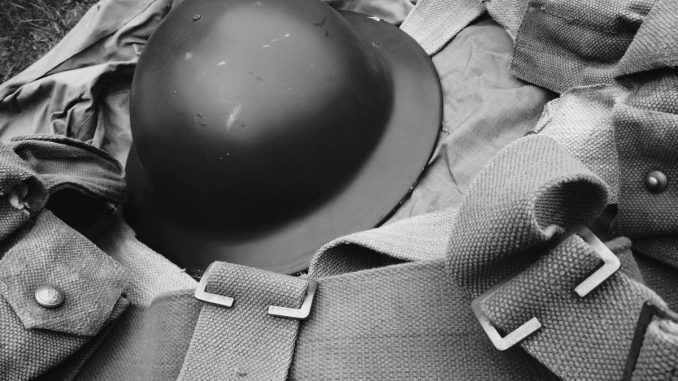

CHARLOTTESVILLE, Va. (AP) — All he wanted was a little COVID-19 distraction, but the century-old photo of a military chaplain took an Albemarle County man on a 102-year time trip to a different state during a different deadly pandemic.
The sepia-toned photo of a man in a World War I-era uniform sits in a swivel frame meant for a tabletop. His round face sports an enigmatic smile and his round-rimmed glasses peer from beneath the brim of an officer’s cap topped with a U.S. Army insignia badge.
Across the mat, in expansive and fluid cursive, is the inscription “Florence, May God Bless You.” It is signed “Regis Barrett, OSB, Chaplain, U.S. Army.”
“I’ve had it for several years,” said Art Beltrone, a local military historian, collector and appraiser of military artifacts. “I obtained it from a Northern Virginia collection of military collectibles and I liked it because it’s a photo of a chaplain and those are difficult to find, especially from the First World War era, because the chaplain corps was small.”
Beltrone said the photo, its dedication and signature caught his eye years ago.
“This one was signed and so it had a connection to an actual person, and that’s always a nice thing. It was in a nice, large frame with a swivel base, so it obviously meant a lot to someone,” he said. “It fascinated me.”
Beltrone is a man driven by fascination. His discovery of canvas bunks festooned with graffiti scrawled by soldiers, sailors and Marines aboard the General Nelson M. Walker, a Vietnam-era troop ship, led to the nationally known Vietnam Graffiti Project, which preserved the hopes, fears and jokes of men going to war.
In the time of COVID-19, with everyone warned to stay home as much as possible, Beltrone found himself with a lot of time and home projects on his hands. He began to see the portrait of the chaplain in a different light.
“I never really took the time to research the photograph before,” he said. “But I began to wonder who this person was and what he did in the military. I found myself wanting to know more about him. I’m really into checking into the names of people involved with artifacts and I found myself with lots of time, so …”
***
Beltrone started digging into Chaplain Barrett. What he found was synchronicity with a time a century ago, when people were warned to mask up when they went out and to stay in when possible as an infectious and often fatal virus spread about the land.
“It turned out that he played into the 1918 pandemic in a big way,” Beltrone said.
Barrett, a Catholic priest of the Order of St. Benedict, was born on July 29, 1882, somewhere in Pennsylvania, according to military records sent to Beltrone by Marcia McManus, director of the U.S. Army Chaplain Corps Museum in Fort Jackson, South Carolina.
In April 1918, as German forces seized Armentieres, Mount Kemmel and heights south of Ypres, shaking the French, English and American alliance, the 35-year-old priest joined the Army’s chaplain corps.
A month later, he was assigned to chaplain training and Camp Zachary Taylor, a few miles outside of Louisville, then the nation’s largest military training camp.
According to the records, his class scores were pretty good. He received 86 of 100 on his classwork; 79 of 100 on his final examination; 158 of 200 on preaching ability; and 442 of 500 on suitability to being a chaplain.
As the German army attacked on a 70-mile front from Chateau Thierry to Rheims and the American 3rd Infantry Division successfully defended, despite severe bombardment and repeated infantry attacks, Barrett was assigned to the 159th Depot Brigade at Camp Taylor.
In September, as the Army began an offensive to push the Germans back using tanks commanded by then-Maj. George S. Patton and warplanes commanded by Brig. Gen. “Billy” Mitchell, Barrett found himself in a war zone all his own, a fight for which he would be recommended for a promotion to captain for “devotion and self-sacrifice” that were “worthy of the highest praise” and “meritorious service at the base hospital during the influenza epidemic.”
***
According to the Centers for Disease Control and Prevention, more than 100,000 Americans died of the flu during October 1918.
At Camp Taylor, 20% of the barracks became an emergency hospital, and urgent appeals went out for additional nurses.
The camp was big. It had 1,530 buildings across 3,376 acres and housed 47,000 men. On Sept. 24, more than 100 soldiers had the flu. A day later, it was 262. By the end of the month, about 2,100 soldiers were sick.
On Sept. 27, camp leaders enacted a partial quarantine and prohibited soldiers from theaters, restaurants and other public places. Only a dozen soldiers were allowed in camp buildings at the same time.
At one point, according to Louisville historical societies, a sixth of camp personnel was hospitalized and as many as 1,500 died, their coffins taken away under cover of night to keep morale from tanking.
“He realized the desperation that was setting in at the camp with 14,000 sick patients and 800 deaths between September and November,” Beltrone said of Barrett. “They were short on doctors and nurses and it was getting desperate.”
That’s where Barrett stepped up. Kentucky nurse educators Sara Bolten and MaryAnn Thompson wrote of his efforts to recruit Catholic nuns to serve in the camp in their treatise, “They Buckled on the Armor of God: Kentucky Catholic Sister ‘Nurses’ in the 1918 Flu Pandemic.”
“Father Barrett’s unorthodox methods included breaking the lock and hinge of a convent screen door when his knock went unanswered, demanding to know how many nurses he could take back to the camp immediately,” they wrote.
Barrett recruited nuns from around the state, including the Sisters of Loretto some 50 miles away in Nerinx, and Sisters of Charity of Nazareth, in Nazareth, about the same distance away. His efforts recruited 88 nuns, some of whom had nursing experience and others who were educators, into the camp to serve.
According to Bolten and Thompson, the women worked 12-hour shifts seven days a week. At least 22 sisters contracted the flu and many suffered long-lasting effects from the disease. One nun, Sister Mary Jean Connor of the Sisters of Loretto, died of the flu and received a military funeral at the camp.
***
The pandemic would fall and rise for another year. Barrett received his commission to captain in May 1919 and continued serving at the camp, transferring to the 28th Infantry Division in October 1919.
In March 1920, Barrett’s superior in his religious order asked him to resign from the military to serve the church in southwestern Colorado, where an abbey was being built and ministerial help was needed. He was honorably discharged the same month, but requested to remain as a reserve officer in the Army’s chaplain corps, which was approved in June 1920.
The story doesn’t end there, because Barrett’s service didn’t end.
He served at the Canon City, Colorado, Abbey of the Holy Cross, riding across the state from Denver and Boulder to Pueblo and Grand Junction as a circuit priest for small parishes.
Barrett befriended the McNichols family, which would became one of the most powerful families in Denver and Colorado politics. He was well respected in the state, which was still considered to be on the frontier.
According to records and personal accounts, when the country went to war again, Barrett sought to rejoin the Army as a chaplain in 1942. At 60, he was considered too old for the regular chaplain corps, but was accepted as an auxiliary chaplain and volunteered to go where needed.
He landed in Africa with the Douglas Aircraft Co. at a repair center and airbase with both military and civilian contractors. The North African campaign was wrapping up and the airbase brought military aircraft in from several theaters for repair and served as a transportation center for personnel and materiel heading to Italy, Russia and China.
It also provided a gathering place for diseases brought onto the base from across the military campaigns, including typhus, malaria, cholera and yellow fever. Base officials struggled with balancing the quarantining of new arrivals with the need to fight a war, according to first-person accounts.
Barrett fit in, serving both military members and civilians, according to first-person accounts, including celebrating a Christmas Eve field Mass attended by most of the base personnel.
Within seven months, however, Barrett would be dead.
***
Early reports state that he died heroically in action beside the troops, but it was actually an infection of streptococcus pneumoniae bacteria that stopped him on July 12, 1943, about two weeks short of his 61st birthday.
“The Military Ordinariate announced that the Rev. Regis Barrett, O.S.B., died in Africa of a streptococcus infection,” The Denver Catholic newspaper reported on July 29, 1943, on what was Barrett’s birthday.
The paper also carried a first-person account of Barrett’s death and funeral from William H. “Bill” McNichols Jr., who later served in the European theater, winning medals for valor, and as Denver’s mayor from 1968 to 1983.
“About one half-hour ago, I returned from the funeral of Father Regis. He died in the hospital after two weeks’ illness of bronchial trouble, later complicated by septicemia and pneumonia,” McNichols wrote. “The funeral was the largest ever held in these parts. Catholics and non-Catholics were there. Everyone that knew him loved him. His death was indeed a great blow to this base.”
Barrett, a hero of the 1918 pandemic, was buried in a temporary cemetery in Algiers. Sometime after 1948, his body was moved to plot I, row 13, grave 6 of the North Africa American Cemetery in Carthage, Tunisia. He bears no military rank and is listed only as a civilian and a chaplain.
In Colorado, the Abbey of the Holy Cross, which the monks closed in 2006, now houses a winery and vineyards. In its cemetery, a plaque honors Barrett and notes his burial in Africa. A cemetery flagpole, dedicated in 2015 to the monks and nuns and others in the cemetery who served in the military by local American Legion Post 13, bears his name.
Barrett’s story, and others like it, keeps Beltrone fascinated by military artifacts, memorabilia and the people connected to them.
“I picked it up because it was just a nice photograph of a World War I Army chaplain in a great frame,” Beltrone said. “But the man and his story make it a relevant historical artifact during this historical time we are living through, the daily events we read about and the daily pandemic reports and news coverage. History has a way of happening again and again.”
This article was written by BRYAN MCKENZIE, The Daily Progress from The Associated Press and was legally licensed through the NewsCred publisher network. Please direct all licensing questions to legal@newscred.com.
© Copyright 2020 The Associated Press. All rights reserved. This material may not be published, broadcast, rewritten or redistributed.





Be the first to comment